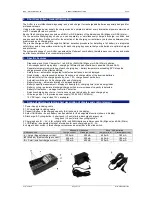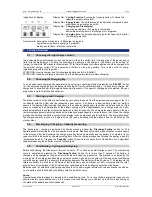
MEC
– Energietechnik GmbH
OPERATING INSTRUCTIONS
AV4m
Vers.: 07/2011
Page 3 of 4
GLN: 9008390331330
Indications on display:
Display
1a
=
Cycling Function:
Pushing the Capacity button (3) shows the
capacity in ampere hours (Ah).
Display
2b
=
Energy Index:
The performance of the batteries compared to each
other is shown as energy index (EI).
Display
2a
=
Charging and Discharging:
upwards moving bars
charging is in progress;
downwards moving bars
discharging is in progress;
Display
1b
=
charging time:
Is displayed alternating with the capacity (Ah) after
the charging process.
General valid: downwards moving bars
discharge in progress;
upwards moving bars
charging in progress;
steady and full bars
function completed;
5. Function Overview
5.1.
Choosing the right charge current
The designated maximal charge current can be set via the slide switch (8) at the long side of the device and is
valid for all charging bays. You have the possibility to perform a quick charge of the batter
y via the setting “
L
”
(Large).
Furthermore “
M
” stands for Medium and “
S
” for Small. Basically all new batteries should be charged with
the smallest charge current “
S
“ to guarantee a lifetime as long as possible. This is also valid for charg-
ing/discharging and the cycling mode.
ATTENTION: Use the charger only for rechargeable batteries (NiCd & NiMH)!
ATTENTION: Read the charging instructions from the battery manufacturer before charging!
5.2.
Choosing the charging bay
You can select each charging bay separately
and set its own operating mode via pressing the “
SELECT
“ button
(4). The selected charging bay is indicated via blinking LED at the particular display. It is possible to charge, dis-
charge and to condition (cycling) single batteries simultaneously. If no specific charging bay is selected, the oper-
ating mode is valid for all inserted batteries.
5.3.
Starting up and Charging
The proper start up of the AV4m is performed by connecting the cable from the provided power supply or the 12V
car adapter with the AV4m and the respective power source.
If no battery is inserted during start up, “
nob
“ is
shown in the display. After inserting the battery in the particular charging bay, the AV4m starts a cell check. If this
check succeeds and all parameters of the battery comply with the specifications for a charge start, the AV4m
starts automatically to charge all detected batteries to their full capacity. The charge process is shown in the par-
ticular display segment via moving bars and the already charged capacity in ampere hours (Ah). When the charge
process has finished, the battery symbol in the display is shown statically and full with bars. The information about
the charged capacity is shown in ampere hours (Ah) and alternating with the elapsed time (h) indicated by the
clock symbol.
5.4.
Discharging / Charging
– Capacity measuring
The discharging / charging is performed by shortly pressing
(<2sec) the “
Discharge/Cycling
“ button (5). This
operating mode is indicated by the downwards moving bars. Additionally the discharged ampere hours are shown
in the display. After the discharge the charge process starts automatically and the battery is charged to its full
capacity which is indicated by upwards moving bars. After the charge process has finished the energy index (EI)
is displayed (see 5.5). Pressing the
“
Capacity
“ button (3) shows the capacity (Ah) of the battery. For a significant
capacity measuring the batteries must be fully charged.
5.5.
Conditioning - Cycling and Analysing
Before conditioning, the slide switch (8) must be set to
“
S
“ to choose a small charge current. The conditioning
cycle is activated by pressing the
“
Discharge/Cycling
“ button (5) for more than 2 seconds. The battery is
charged and discharged as long as no more increase in capacity is detected. The process is indicated by the
moving bars, the charged and discharged ampere hours as well as a cycle symbol. At the end of the conditioning
cycle the energy index (EI) is shown in the display segments. The battery with the EI-value of 1.00 represents the
reference battery. An EI-value of 0,95 means that the battery has an efficiency of 95% compared with the refer-
ence battery. A comparison of the EI-Values after conditioning allows an effective selection of batteries.
Batteries used in combination (battery packs) should only show marginal different EI-values because the efficien-
cy of a battery pack is defined by the battery with the lowest EI-value.
Advice:
New batteries should always be trained with a conditioning cycle. For a long lifetime at maximal capacity you
should maintain your batteries every 4 to 6 weeks. One conditioning cycle can last up to 48 hours depending on
the state of the batteries and their capacities.






















